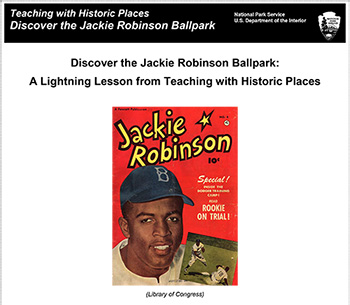Last updated: May 11, 2023
Lesson Plan
Discover the Jackie Robinson Ballpark: A Lightning Lesson from Teaching with Historic Places

- Grade Level:
- Middle School: Sixth Grade through Eighth Grade
- Subject:
- Literacy and Language Arts,Social Studies
- Lesson Duration:
- 60 Minutes
- Common Core Standards:
- 6-8.RH.1, 6-8.RH.2, 6-8.RH.7, 9-10.RH.1, 9-10.RH.2, 11-12.RH.1, 11-12.RH.2
- Additional Standards:
- US History Era 9, Standard 4A: The student understands the “Second Reconstruction” and its advancement of civil rights.
- Thinking Skills:
- Remembering: Recalling or recognizing information ideas, and principles. Understanding: Understand the main idea of material heard, viewed, or read. Interpret or summarize the ideas in own words. Applying: Apply an abstract idea in a concrete situation to solve a problem or relate it to a prior experience. Analyzing: Break down a concept or idea into parts and show the relationships among the parts. Creating: Bring together parts (elements, compounds) of knowledge to form a whole and build relationships for NEW situations. Evaluating: Make informed judgements about the value of ideas or materials. Use standards and criteria to support opinions and views.
Essential Question
How can sports and popular culture influence public opinion? What historic place might you study to answer this question?
Objective
Objectives for students
1. To describe the effects of Jim Crow in the early 20th Century;
2. To explain how American society and law may be affected by popular culture, like sports;
3. To complete a creative arts project about the Civil Rights movement OR To identify a local African American historic site and research its significance.
Background
This lesson can be used in U.S. history, social studies, and other curricula that examine African American history and civil rights in the United States following World War II.
Preparation
“Separate but equal” laws segregated society and culture in the United States for the first half of the 20th century. After World War II, the tide began to turn and one place where Americans saw a change was in professional sports. In 1946, African American baseball player and military veteran Jackie Robinson became the first black man to play on a white team in a segregated league. With support from his wife and community, he broke that “color barrier” during spring training in Daytona Beach, Florida, at the City Island Ballpark.
Robinson earned the title Rookie of the Year in 1947, played in the World Series in 1955, and was a passionate Civil Rights activist when his athletic career ended. The “City Island Ballpark” is listed on the National Register of Historic Places for its association with him and renamed in his honor. This lesson explores Jackie Robinson’s life and the events of 1946, racism and “Jim Crow,” pop culture’s influence on a nation of laws, and the historic beachfront ballpark.
Lesson Hook/Preview
How can sports and popular culture influence public opinion? What historic place might you study to answer this question?
Procedure
- Getting Started Prompt
- Map: Orients the students and encourages them to think about how place affects culture and society
- Readings: Primary and secondary source readings provide content and spark critical analysis.
- Visual Evidence: Students critique and analyze visual evidence to tackle questions and support their own theories about the subject.
- Optional post-lesson activities: If time allows, these will deepen your students' engagement with the topics and themes introduced in the lesson, and to help them develop essential skills.
Vocabulary
Jim Crow: Nickname for the culture, laws, and social norms that supported white supremacy between 19th Century Reconstruction and the 20th Century Civil Rights Movement.
Related Lessons or Education Materials
https://www.nps.gov/subjects/teachingwithhistoricplaces/lightning-lesson-005_jackie-robinson-ballpark.htm
